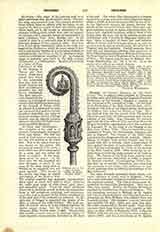

Crosiers (or CANONS REGULAR OF THE HOLY CROSS), the, a religious order, founded by Theodore de Celles, who, after following the Emperor Frederick Barbarossa on the Crusade, obtained a canonry in the Cathedral of St. Lambert at Liege. On the feast of the Exaltation of the Holy Cross (September 14, 1211), Theodore with four of his fellow-canons pronounced his religious vows before the Bishop of Liege. Having received from him the church of St. Theobald at Clair-Lieu, near Huy, de Celles founded there the first convent of the order. Pope Innocent III verbally approved the new order in 1215, and Pope Honorius III gave his written approbation, which was confirmed by Innocent IV on the feast of the Finding of the Holy Cross (May 3, 1248). The new institution soon extended to France, the Netherlands, Germany, and also to England. The Canons of the Holy Cross preached to the Albigenses with St. Dominic. Albert, Bishop of Prague, took several Crosiers and other monks with him to Livonia, where a great many of them gained the glory of martyrdom (1246). Some other Fathers accompanied St. Louis on his journey to the Holy Land in 1248. After returning, he enabled them to build the main convent of the order in Paris. The Canons of the Holy Cross practice both interior and exterior self-denial, in order to imitate the Savior crucified. Contemplating Christ’s Passion they try to sanctify themselves, and, preaching the mysteries of the Cross, they endeavor to save others, inducing them to follow in the footsteps of the Man of Sorrows.
The order formerly possessed about ninety convents, nineteen of which were in England. These latter were destroyed during the troublesome times of the sixteenth century. The Dutch houses were despoiled at the time of the Reformation. Only two of them were spared. Finally, the French Revolution expelled the Crosiers from France and Belgium. The two remaining convents in Holland (at St. Agatha and Uden in North Brabant) were likewise doomed to extinction by King William, who ordered them not to admit novices. His successor, however, retracted this interdict (September 14, 1840), and, from that time, the order commenced to flourish again. From these convents three large branches were founded in Belgium, at Diest (1845); at Maeseyck (1854); at Hannut (1904); while the convent of Uden has been totally renewed (1905), and the mother-house at St. Agatha restored (1907). In 1857 the master general of the order sent some missionaries to Bay Settlement, Wisconsin, U.S.A., but the undertaking failed on account of insuperable difficulties. Pope Urban VIII gave to the master general, August Neerius, and his successors, the privileges of purple, crosier-staff, mitre, and pontificalia, together with some other exceptional favors (1630). Pope Leo X added the special faculty of blessing rosaries or chaplets, so that on a rosary indulgenced by Crosiers 500 days of indulgence are to be gained each time a Pater or Ave is said. The Indulgence is also applicable to the souls in purgatory (Gregory XVI, decrees of September 15, 1842; July 13, 1845; Pius IX, January 9, 1848). Pope Pius X decreed that both the Crosier and the Dominican Indulgences may be gained together on condition that a whole chaplet is said.
After one year of probation the Crosier novice enters into the order by a simple but perpetual profession; the solemn profession follows three years thereafter. The priests and the professed clerics wear a white tunic, over which is a black scapular; a short black mantle (mozetta) and a hood of the same color complete their costume. Upon the breast of the scapular a cross is sewed, the upright bar of which is red, and the cross-bar white. A prior presides over each convent and the order is governed by a master general, elected for life, fifty-two having ruled from the foundation to 1908. As their particular patroness the Crosiers venerate St. Odilia, a companion of St. Ursula, who is said to have appeared in Paris to a lay brother of the order, named Jean de Novellan (1387), after which her relics were found at Cologne and brought to the mother-house at Huy. A great many pilgrims visit the churches of the Crosiers during the octave of St. Odilia’s Feast (July 18), in order to obtain her protection, and to be cured from ophthalmy, and water blessed in honor of St. Odilia is sent on request by the Crosiers all over the world. The life of the Crosier Fathers is both contemplative and active. They give missions, retreats, and assist the secular clergy when asked. They also educate young men aspiring to the priesthood in their colleges.
H. YZERMANS

